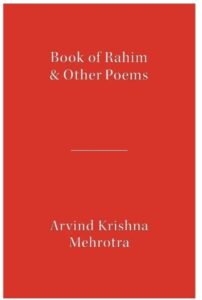A LITERARY REVIEW BY SHRESTHA MUKHERJEE
BOOK OF RAHIM AND OTHER POEMS
It is dubiously strange how our recollection of thoughts functions within us. We see a folded page inside an old book that once used to be the most cherishable possession of ours in youth but now we wonder, ‘Why is it kept folded like this?’ There are moments in our lives where we are off-guarded by our own candid feelings and we sow those fleeting seconds reprimanding our existences, which are now left behind somewhere far in the woods of our past lives. Yet, we exist in every second of our spent moments. Be it somewhere behind the ‘doors that have ears,’ in the ‘kitchen basket beside the window,’ several ‘known and unknown faces in the neighbourhood,’ shabby ‘post office’ or wherever we tend to exist, we exist.
In fact, there are uncountable songs or verses that we hold in accord to be forgone or forgotten from our life, but once recollection chases us, they whirlpool off the shore and plunge us with its retreating waves. Could we be under our sea of thought forever like that? Presumably not. But as long as the waves keep coming back on the shore and we tend to dip our feet in those splashes, our parted existence gets recreated to remain a little longer.
The renowned Indian poet, translator and editor of several anthologies, Arvind Krishna Mehrotra, has gone through thick and thin to navigate that kind of individualistic persona that is an accumulation of bits and pieces of history, nostalgia and reminiscences inspired by the mortal life and has done this with his ingenious anthology, ‘Book of Rahim and Other Poems.’
As quoted from the book, ‘His first collection in twenty five years, Arvind Krishna Mehrotra’s Book of Rahim and Other Poems contains extraordinary records of every day, as well as a frequent reimagining of history that makes it as commonplace as a relative on a piece of furniture, and all the more strange and unrepeatable because of that,’ one can get a brief understanding that along with extolling life on various levels, Mehrotra has also paid his tribute to the two most ingeniously timeless poets of Indian subcontinent– Abdul Rahim Khan-i-Khanan and Mirza Ghalib.
As a byproduct of ‘Literary Activism,’ a platform that has arranged symposiums since 2014 to discuss those literary creative foundations no longer practised in the contemporary construct or academia, this anthology is an account of short-lived historical sequences and shreds of autobiography. Starting with the first section, ‘Book of Rahim,’ the poet has presented four poems on the life and works of Indian poet Rahim, one of the Navaratnas in the court of Emperor Akbar. Mehrotra has also translated one of Rahim’s couplets, popularly known as ‘Doha’ or ‘Dohe’ for this section of the anthology in English. Whenever we recall our primary lessons in Hindi literature in school, ‘Rahim ke Dohe’ was one of the most significant readings in the list of our context. Seamlessly stuck in our memories, Rahim’s couplets somehow retained with us even though most of us are not well-versed in his life. The ending lines of the poem, ‘Schoolboy’s Rahim,’ say:
We read him in school. The alphabet was familiar,
but you scrunched up the eyes to read the page.
The meaning had to be cribbed. Hindi was grief,
and grief the sports field if you missed a sitter.”
In the section, ‘Rahim: Dohas,’ Mehrotra has translated numerous couplets of Rahim in ten pages. His rhymes have left such an aphoristic impact on his readers that they imbibe the meaning of life with a philosophical perspective in a simple yet witty language. Mehrotra, without changing the sense and mood of the couplets has translated them and has given lucidity to its language.
The next section of the book ‘Ghalib, A Diary,’ is the sequential verse that describes the downfall of the Mughal Empire within a brink in front of Ghalib himself. The poet has given voice to a grieving Ghalib, whose eyes revolve around destruction and diminishment. Though Ghalib has avoided being overtly critical of the political situation and the burning of Delhi, his diary is mostly a personal accord to his feelings, a monologue of vanity, an unspoken bond between him and Emperor Bahadur Shah Zafar, and a grim for unending war left in the eternal silence post-war. In the line, “It’s what you’re left with in the end, the vacancy of grief,” the poet narrates the silence residing between the Mughal Court during the declining era of Emperor Zafar. It reflects the symbolism of silence of exile, poetry, the war and the associated decline of the Mughals and the subtleties of empty spaces. For Ghalib, War is a performance of mockery, a farce destroying kins against kins. Through these lines, Ghalib is trying to ponder around for the causes that let people hail war instead of anything that doesn’t associate bloodshed, “When their vengeful guns fired, it was sepoy against sepoy, rebel against their kin, both drawn from the same pool of rustics,” Closely associated with the meaning of these lines, we can undeniably draw a comparison from the poem, “Strange Meeting” by Wilfred Owen,
“I am the enemy you killed, my friend.
I knew you in this dark: for so you frowned
Yesterday through me as you jabbed and killed.
I parried; but my hands are loathe and cold.
Let us sleep now….”
In his following two sections, “Book of Lahore ” and “Laughing Club of Gandhi Park,” Arvind Krishna Mehrotra’s poetic montage of cinematic sequences are expressed at its pinnacle. Be it observed from the mundaneness of the morning sun glistening over the park benches, narrating the poet’s life in Delhi where he has seen the human world on distinguished dimensions or his short-lived childhood, left in the cosy alleys of Lahore, these poems are a tribute to a lived-nostalgia. In the poem, ‘Beni Bazaar,’ Mehrotra refers to the disposal of clock shops counting every second into the pit of the fast-paced world of digitisation that doesn’t have a second to spare, “His is the last remaining shop in Beni Bazaar. Sitting by himself under a row of grandfather clocks,” Elsewhere, in the poem ‘Laugh Club of Gandhi Park,’ the poet has described the alienation of urban life where people hide their emotions behind the curtain of concrete roads, smokey air and imposed giddy waves of laughter,
“You see them
in Gandhi Park,
on opposite benches,
practising their skills,
a smokescreen
of laughter
hiding their faces.”
Lastly, Mehrotra’s poetic genius can never be wrapped up without the mention of his broken memoir prose ‘11 Temple Road,’ which is a recollection of his days back in Lahore, and the write-up has been bulked up with notes, letters, photographs and memory narrations, he has received from his family in Lahore. Once you leave your past behind, you can never relive those moments again, but our memories are the only loose thread that binds us together in this universal phenomenon of kinship we share. The ending lines of this prose convey the metaphor of nostalgia and recollection of the past poignantly:
“Countries keep disappearing off the face of the map or changing their shapes or their names, but a piece of land remains where it’s always been, fixed in geography if not in history and schoolboy stamp albums. Perhaps this is why Indians, when they return from abroad, make the gesture of bending and touching the soil, then bringing their fingers to their foreheads. It is not, as they believe, the soil of a country that they touch but, symbolically, they are kissing the earth. They have returned home.”
Also, read A Literary Review On Robin S. Ngangom’s ‘The Desire Of Roots’ A book review by Shrestha Mukherjee and published in The Antonym:
A Literary Review on Robin S. Ngangom’s ‘The Desire of Roots’
Follow The Antonym’s Facebook page and Instagram account for more content and exciting updates.



























0 Comments